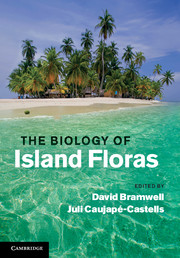Book contents
- Frontmatter
- Contents
- Contributors
- Preface
- 1 Introduction: islands and plants
- 2 The reproductive biology of island plants
- 3 Spatial methodologies in historical biogeography of islands
- 4 Origin and evolution of Hawaiian endemics: new patterns revealed by molecular phylogenetic studies
- 5 Origins and evolution of Galapagos endemic vascular plants
- 6 The plants of the Caribbean islands: a review of the biogeography, diversity and conservation of a storm-battered biodiversity hotspot
- 7 The biogeography of Madagascar palms
- 8 Evolution and biogeography of the flora of the Socotra archipelago (Yemen)
- 9 Biogeography and conservation of the flora of New Caledonia
- 10 Phytogeography and relationships of the Pitcairn Islands flora
- 11 Chromosomes and evolution in New Zealand endemic angiosperms and gymnosperms
- 12 Jesters, red queens, boomerangs and surfers: a molecular outlook on the diversity of the Canarian endemic flora
- 13 Endemism and evolution in Macaronesian and Mediterranean Limonium taxa
- 14 Dispersal, diversity and evolution of the Macaronesian cryptogamic floras
- 15 Invasive alien species and islands
- 16 Ecology, demography and conservation in the Galapagos Islands flora
- 17 New directions and challenges for the conservation of the flora of Madagascar
- 18 Climate change and island floras
- 19 Conservation status of endemic plants on Isla del Coco, Costa Rica: applying IUCN Red List criteria on a small island
- 20 Botanic gardens and the conservation of island floras
- 21 The hazardous future of island floras
- Index
- References
5 - Origins and evolution of Galapagos endemic vascular plants
Published online by Cambridge University Press: 07 October 2011
- Frontmatter
- Contents
- Contributors
- Preface
- 1 Introduction: islands and plants
- 2 The reproductive biology of island plants
- 3 Spatial methodologies in historical biogeography of islands
- 4 Origin and evolution of Hawaiian endemics: new patterns revealed by molecular phylogenetic studies
- 5 Origins and evolution of Galapagos endemic vascular plants
- 6 The plants of the Caribbean islands: a review of the biogeography, diversity and conservation of a storm-battered biodiversity hotspot
- 7 The biogeography of Madagascar palms
- 8 Evolution and biogeography of the flora of the Socotra archipelago (Yemen)
- 9 Biogeography and conservation of the flora of New Caledonia
- 10 Phytogeography and relationships of the Pitcairn Islands flora
- 11 Chromosomes and evolution in New Zealand endemic angiosperms and gymnosperms
- 12 Jesters, red queens, boomerangs and surfers: a molecular outlook on the diversity of the Canarian endemic flora
- 13 Endemism and evolution in Macaronesian and Mediterranean Limonium taxa
- 14 Dispersal, diversity and evolution of the Macaronesian cryptogamic floras
- 15 Invasive alien species and islands
- 16 Ecology, demography and conservation in the Galapagos Islands flora
- 17 New directions and challenges for the conservation of the flora of Madagascar
- 18 Climate change and island floras
- 19 Conservation status of endemic plants on Isla del Coco, Costa Rica: applying IUCN Red List criteria on a small island
- 20 Botanic gardens and the conservation of island floras
- 21 The hazardous future of island floras
- Index
- References
Summary
Thirty years ago, Porter (1979) summarised what was then known of the origins and evolution of Galapagos endemic vascular plants. He concluded that 43% of indigenous taxa (231 out of 543 species, subspecies and varieties) were endemic, although this figure included six questionably endemic and 14 questionably distinct taxa plus 13 others known only from the type or not collected for at least 45 years. Removing those led to 186 endemics in a total vascular flora of 498 taxa (37% endemic). This percentage endemism is higher than some published estimates, partly because Porter (1976, 1979, 1983) excluded from the indigenous flora 47 species that he regarded as introduced by people, but which have been treated as native by others (e.g. Lawesson et al., 1987). Porter (1979) recognised 192 naturalised introduced taxa (including the 47 that were treated as native by Lawesson et al., 1987). Porter (1979) recognised seven endemic genera, and radiations that had produced at least three endemic taxa in ‘19’ genera (actually 21 according to his systematic list, including two about which some doubt was expressed), plus ‘10’ more genera (12 in his systematic list including two less certain ones) which had produced two endemics by radiation. He suggested that birds had played the most important role in dispersing plants to the islands.
- Type
- Chapter
- Information
- The Biology of Island Floras , pp. 89 - 153Publisher: Cambridge University PressPrint publication year: 2011
References
- 26
- Cited by



